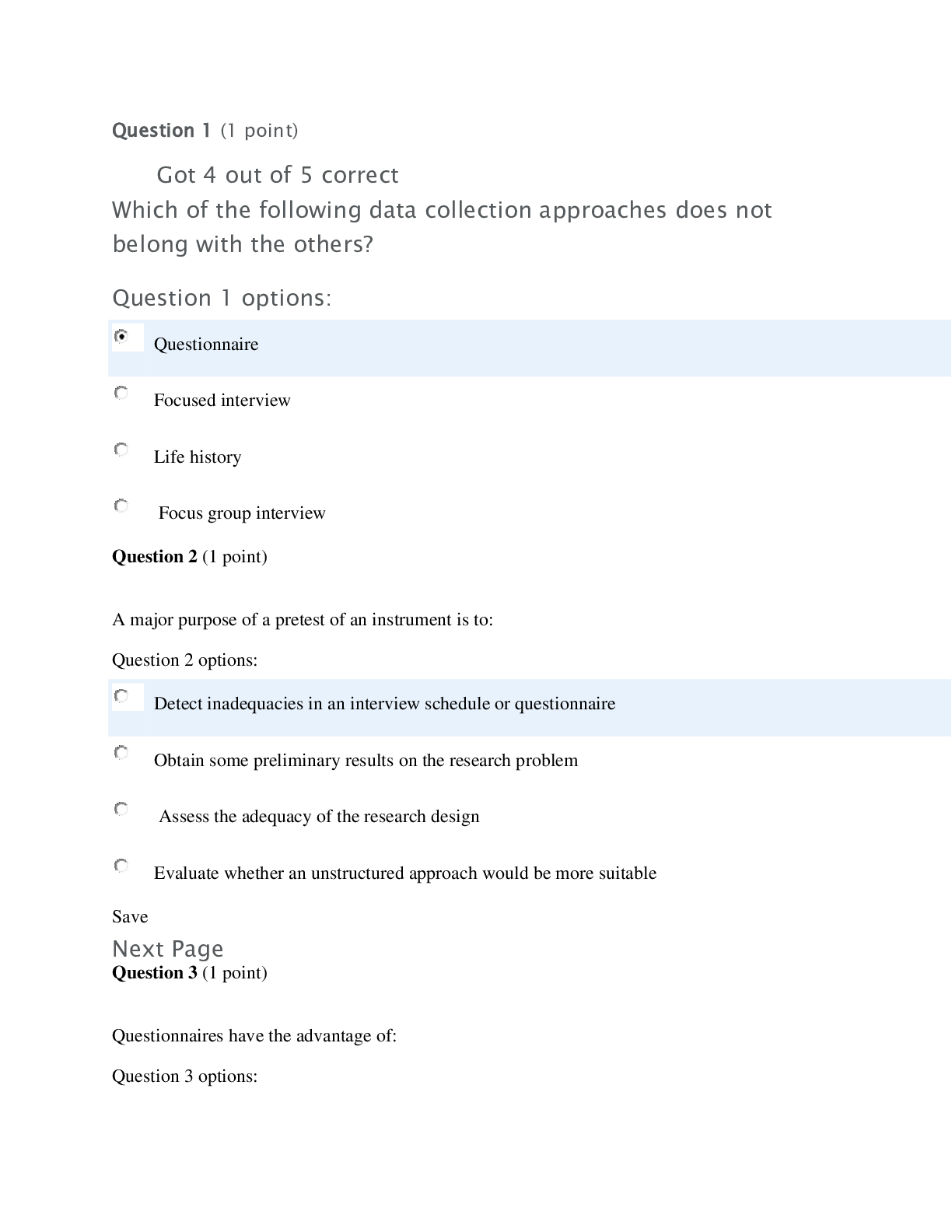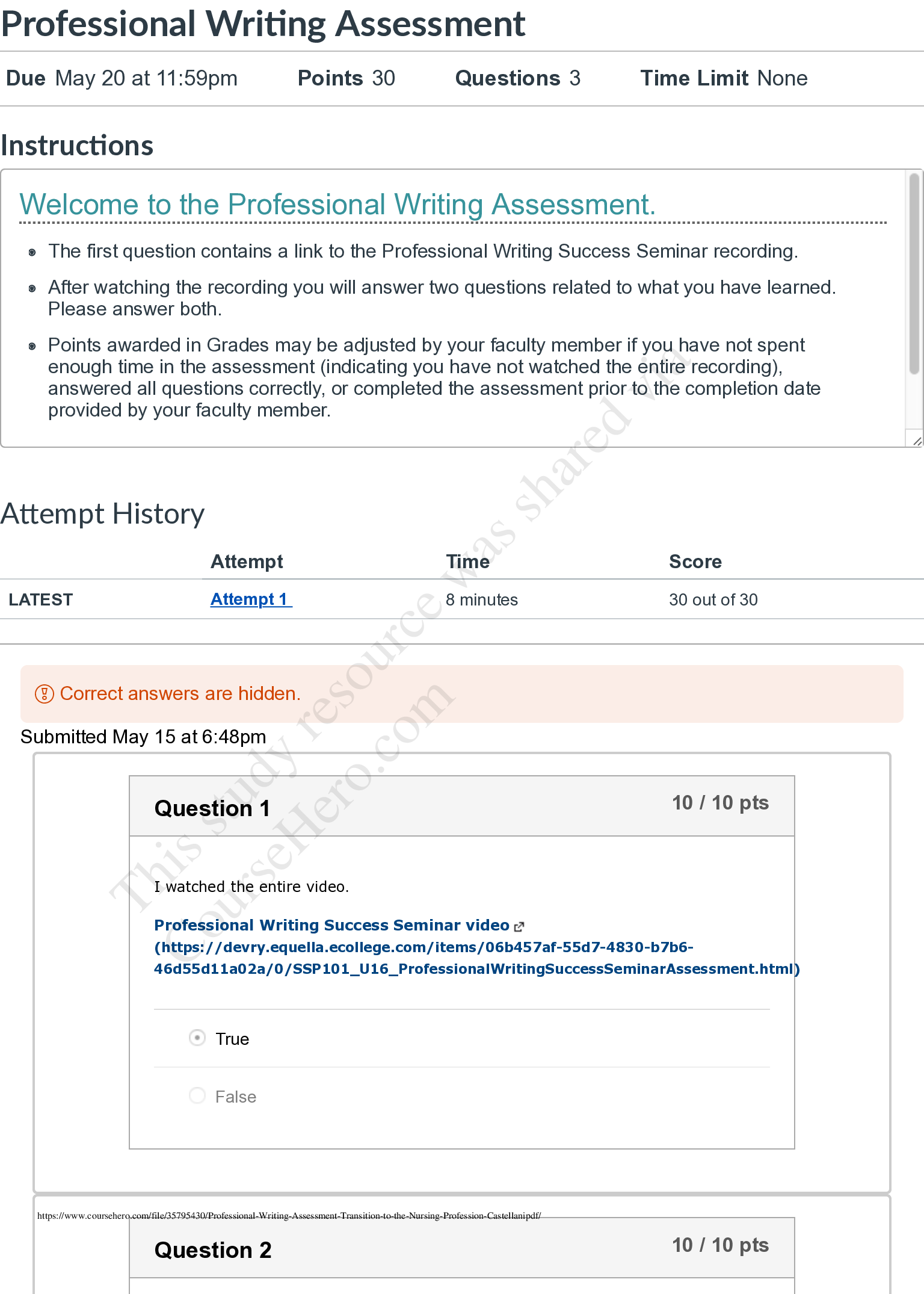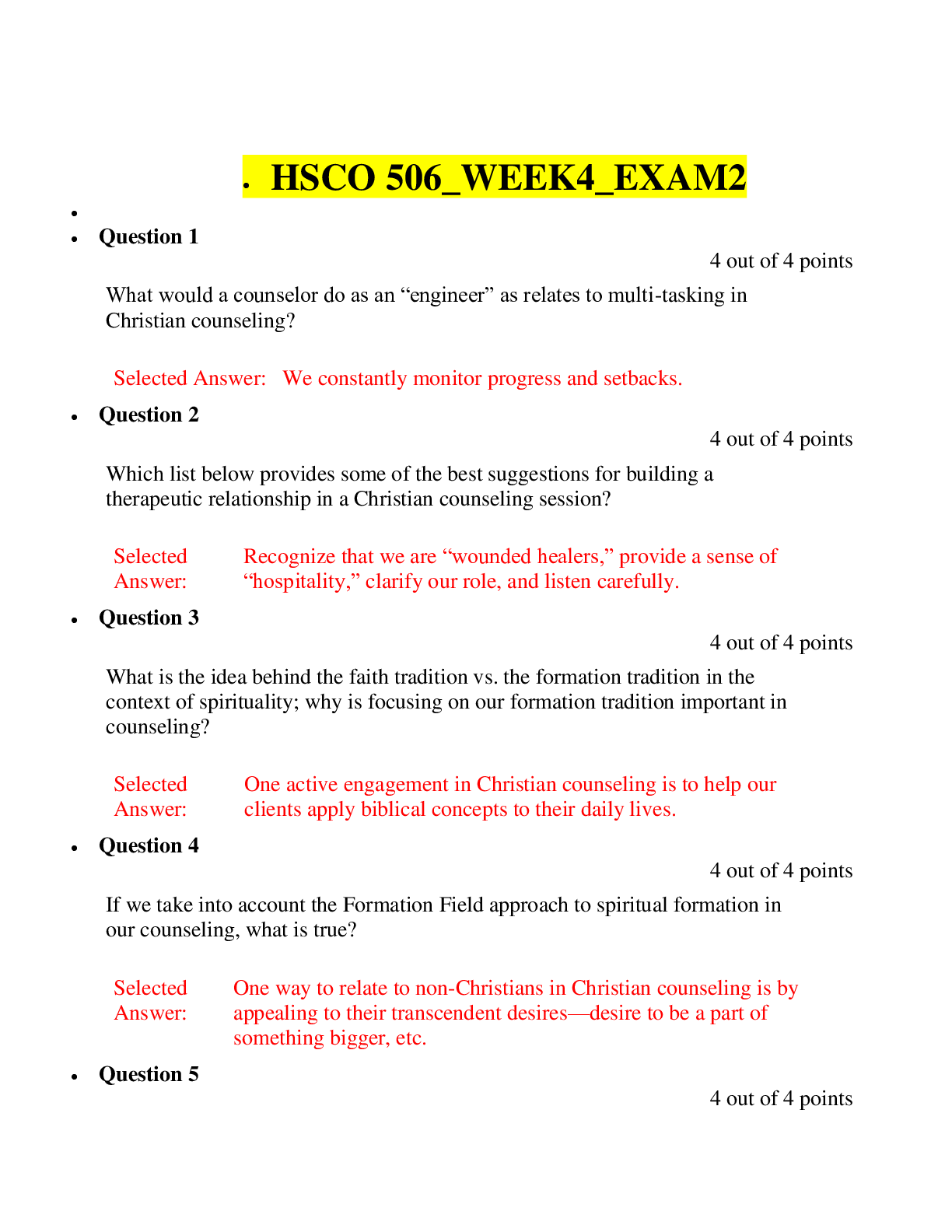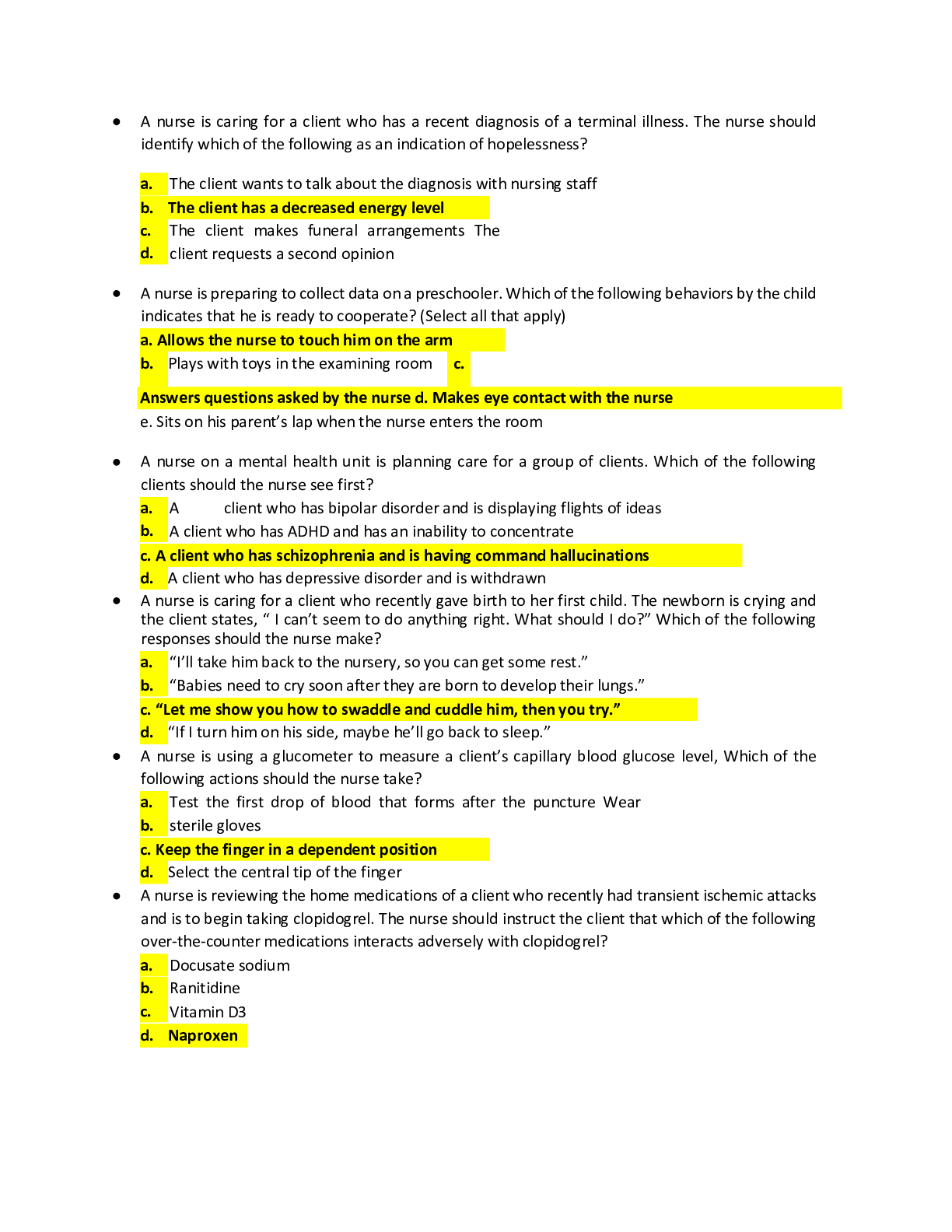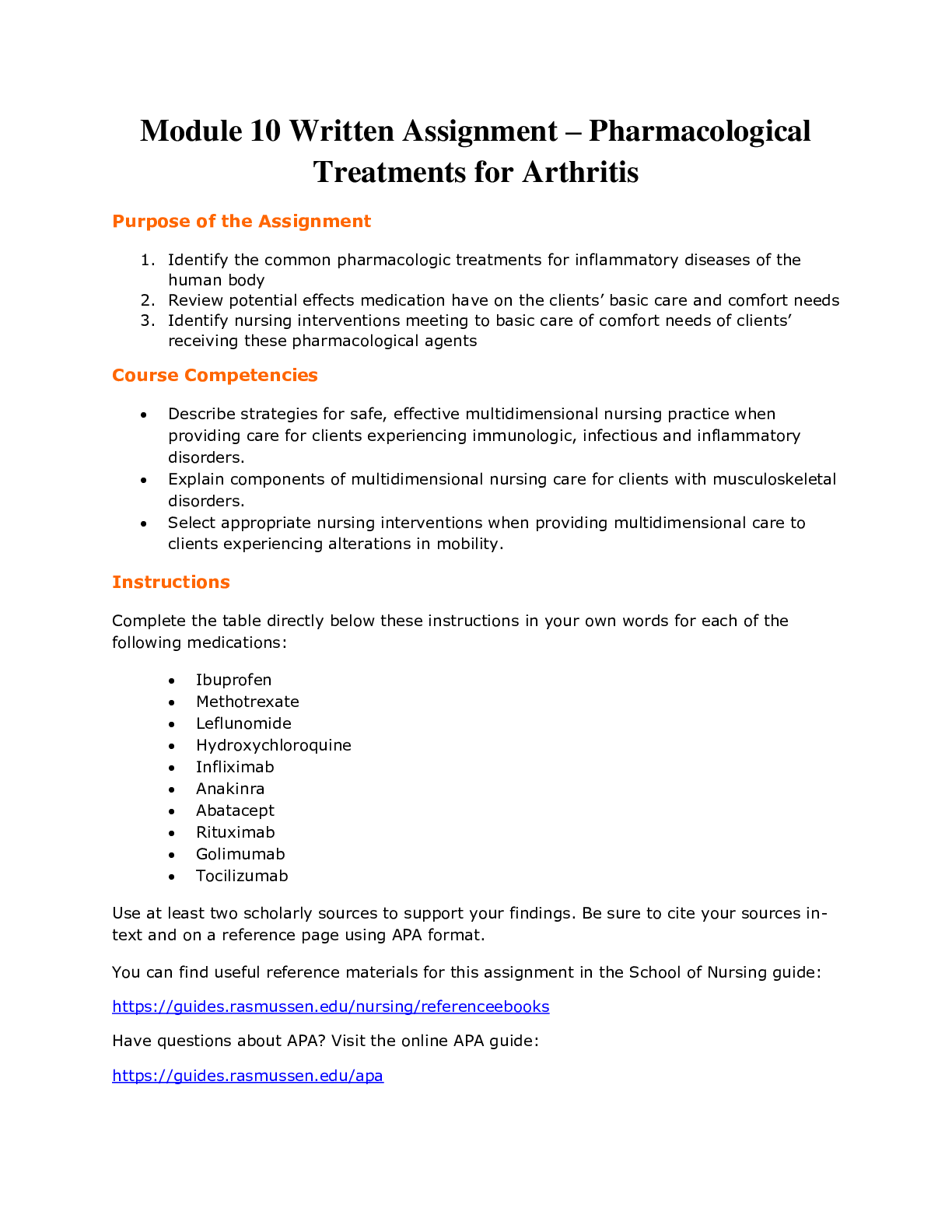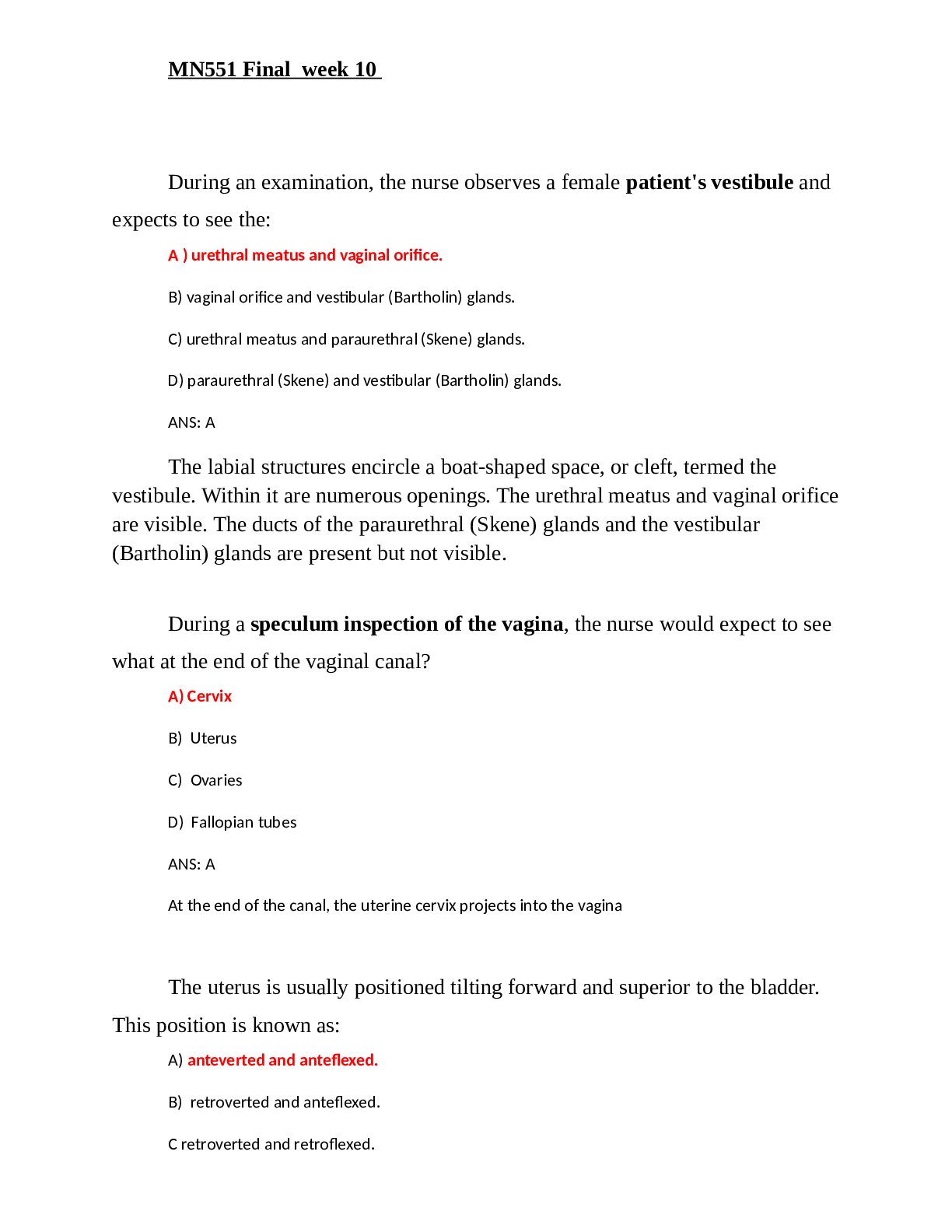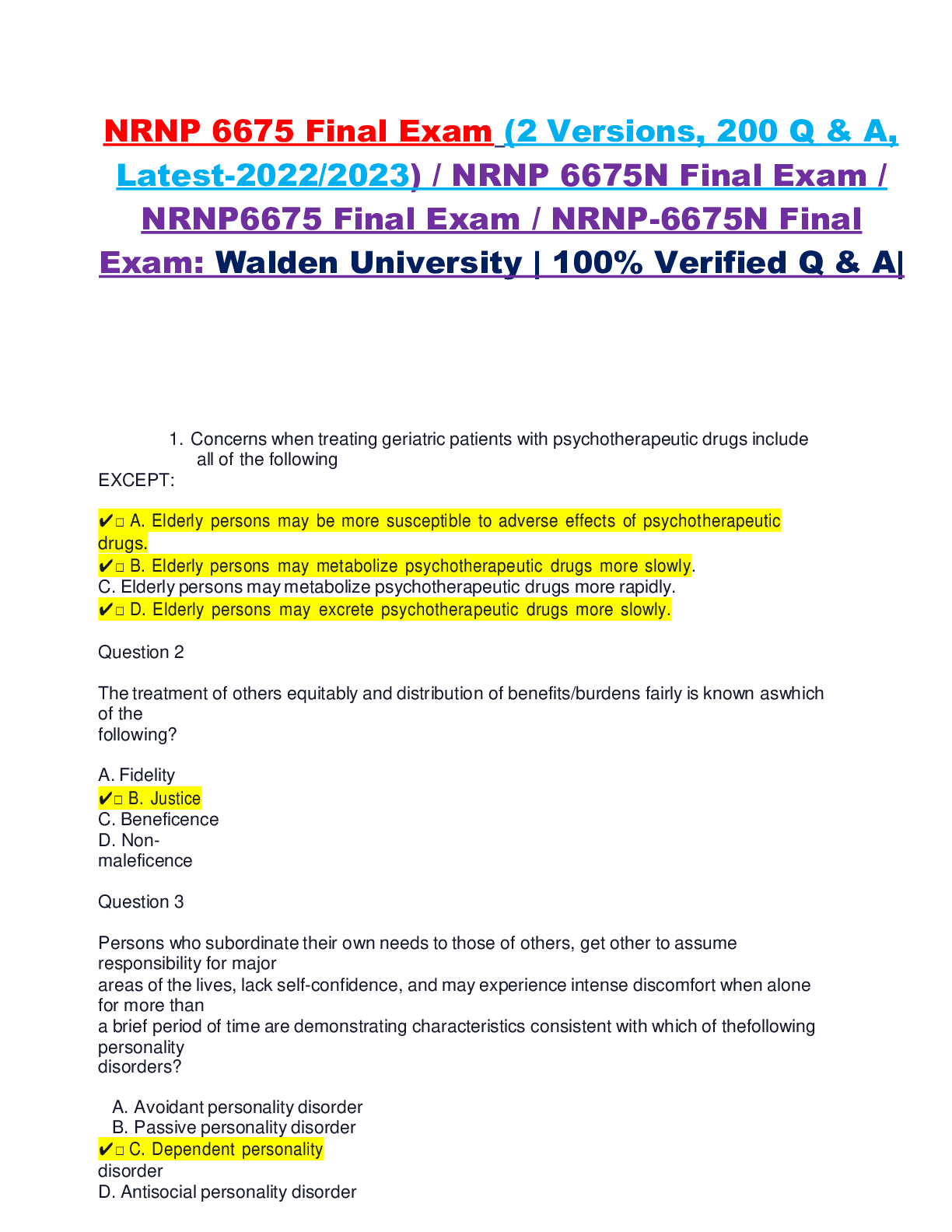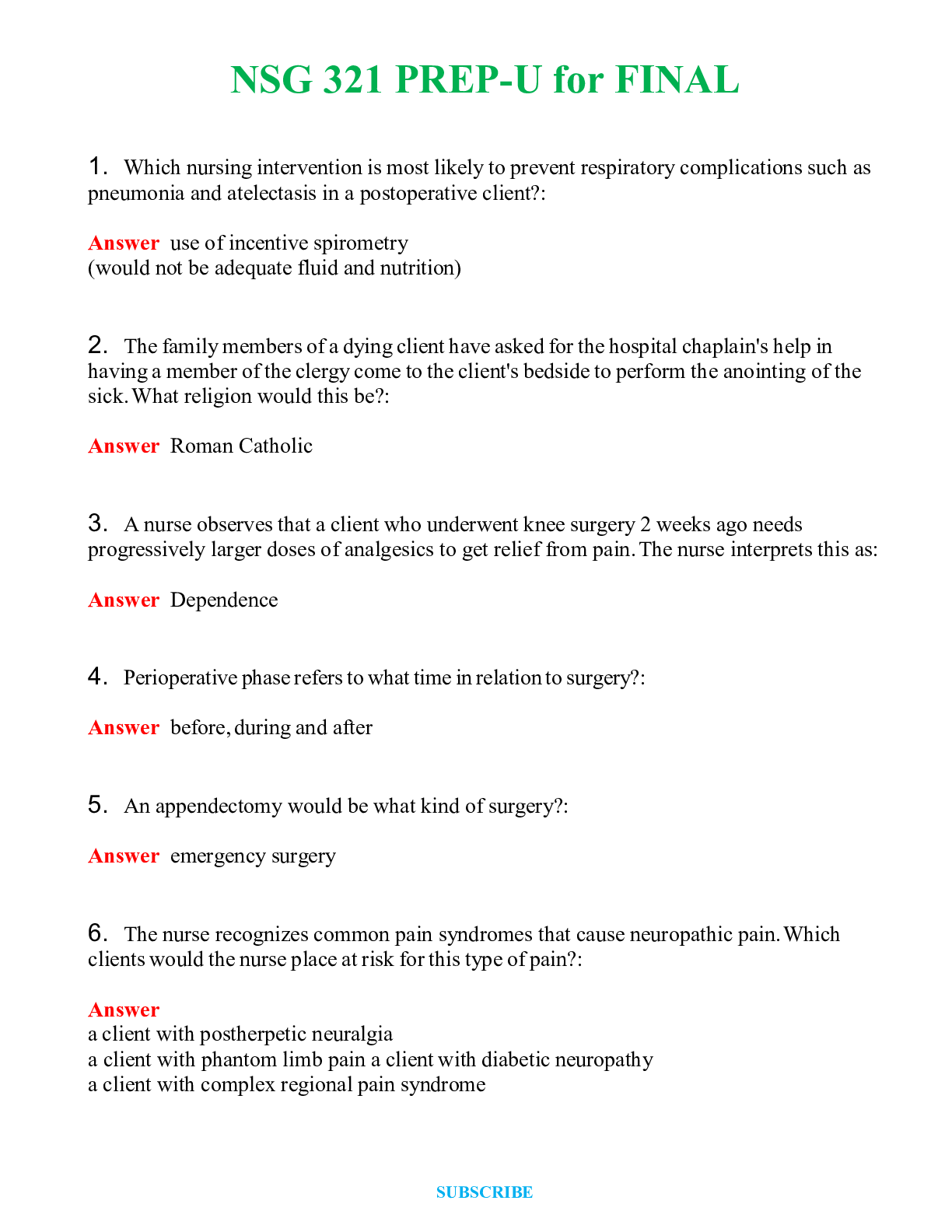MN 553 Final Purdue Global University 2023
Document Content and Description Below
MN 553-Final Acute Pain 6. Which of the following statements is true about acute pain? 1. Somatic pain comes from body surfaces and is only sharp and well-localized. 2. Visceral pain comes fr... om the internal organs and is most responsive to acetaminophen and opiates. 3. Referred pain is present in a distant site for the pain source and is based on activation of the same spinal segment as the actual pain site. 4. Acute neuropathic pain is caused by lack of blood supply to the nerves in a given area. 7. One of the main drug classes used to treat acute pain is NSAIDs. They are used because: 1. They have less risk for liver damage than acetaminophen. 2. Inflammation is a common cause of acute pain. 3. They have minimal GI irritation. 4. Regulation of blood flow to the kidney is not affected by these drugs. 10. The goal of treatment of acute pain is: 1. Pain at a tolerable level where the patient may return to activities of daily living 2. Reduction of pain with a minimum of drug adverse effects 3. Reduction or elimination of pain with minimum adverse reactions 4. Adequate pain relief without constipation or nausea from the drugs 13. Pathological similarities and differences between acute pain and chronic pain include: 1. Both have decreased levels of endorphins. 2. Chronic pain has a predominance of C-neuron stimulation. 3. Acute pain is most commonly associated with irritation of peripheral nerves. 4. Acute pain is diffuse and hard to localize. Allopurinol 17. Which antigout medication is used to treat chronic tophaceous gout? a. Allopurinol (Zyloprim) b. Colchicine c. Probenecid (Benemid) d. Sulfinpyrazone (Anturane) 18. The nurse is assessing a patient who has gout who will begin taking allopurinol (Zyloprim). The nurse reviews the patient’s medical record and will be concerned about which laboratory result? a. Elevated BUN and creatinine b. Increased serum uric acid c. Slight increase in the white blood count d. Increased serum glucose 19. The nurse provides teaching for a patient who will begin taking allopurinol. Which statement by the patient indicates understanding of the teaching? a. I should increase my vitamin C intake. b. I will get yearly eye exams. c. I will increase my protein intake. d. I will limit fluids to prevent edema. 3. Larry is taking allopurinol to prevent gout. Monitoring of a patient who is taking allopurinol includes: 1. Complete blood count 2. Blood glucose 3. C-reactive protein 4. BUN, creatinine, and creatinine clearance Angina 20. Isosorbide dinitrate is prescribed for a patient with chronic stable angina. This drug is administered twice daily, but the schedule is 7 a.m. and 2 p.m. because: 1. It is a long-acting drug with potential for toxicity. 2. Nitrate tolerance can develop. 3. Orthostatic hypotension is a common adverse effect. 4. It must be taken with milk or food. 21. Art is a 55-year-old smoker who has been diagnosed with angina and placed on nitrates. He complains of headaches after using his nitrate. An appropriate reply might be: 1. This is a parasympathetic response to the vasodilating effects of the drug. 2. Headaches are common side effects with these drugs. How severe are they? 3. This is associated with your smoking. Let’s work on having you stop smoking. 4. This is not related to your medication. Are you under a lot of stress? 20. Elderly patients who are started on levothyroxine for thyroid replacement should be monitored for: 1. Excessive sedation 2. Tachycardia and angina 3. Weight gain 4. Cold intolerance 1. Angina is produced by an imbalance between myocardial oxygen supply (MOS) and demand (MOD) in the myocardium. Which of the following drugs help to correct this imbalance by increasing MOS? 1. Calcium channel blockers 2. Beta blockers 3. Angiotensin-converting-enzyme (ACE) inhibitors 4. Aspirin 3. The New York Heart Association and the Canadian Cardiovascular Society have described grading criteria for levels of angina. Angina that occurs with unusually strenuous activity or on walking or climbing stair after meals is class: 1. I 2. II 3. III 4. IV 4. Patients at high risk for developing significant coronary heart disease are those with: 1. LDL values between 100 and 130 2. Systolic blood pressure between 120 and 130 3. Class III angina 4. Obesity 5. To reduce mortality, all patients with angina, regardless of class, should be on: 1. Aspirin 81 to 325 mg/d 2. Nitroglycerin sublingually for chest pain 3. ACE inhibitors or angiotensin receptor blockers 4. Digoxin 6. Patients who have angina, regardless of class, who are also diabetic, should be on: 1. Nitrates 2. Beta blockers 3. ACE inhibitors 4. Calcium channel blockers 7. Management of all types and grades of angina includes the use of lifestyle modification to reduce risk factors. Which of these modifications are appropriate for which reason? Both the modification and the reason for it must be true for the answer to be correct. 1. Lose at least 10 pounds of body weight. Excessive weight increases cardiac workload. 2. Reduce sodium intake to no more than 2,400 mg of sodium. Sodium increases blood volume and cardiac workload. 3. Increase potassium intake to at least 100 mEq/d. The heart needs higher levels of potassium to improve contractility and oxygen supply. 4. Intake a moderate amount of alcohol. Moderate intake has been shown by research to improve cardiac function. 8. Nitrates are especially helpful for patients with angina who also have: 1. Heart failure 2. Hypertension 3. Both 1 and 2 4. Neither 1 nor 2 9. Beta blockers are especially helpful for patients with exertional angina who also have: 1. Arrhythmias 2. Hypothyroidism 3. Hyperlipidemia 4. Atherosclerosis 10. Rapid-acting nitrates are important for all angina patients. Which of the following are true statements about their use? 1. These drugs are useful for immediate symptom relief when the patient is certain it is angina. 2. The dose is one sublingual tablet or spray every 5 minutes until the chest pain goes away. 3. Take one nitroglycerine tablet or spray at the first sign of angina; repeat every 5minutes for no more than two doses. If chest pain is still not relieved, call 911. 4. All of the above 12. Combinations of a long-acting nitrate and a beta blocker are especially effective in treating angina because: 1. Nitrates increase MOS and beta blockers increase MOD. 2. Their additive effects permit lower doses of both drugs and their adverse reactions cancel each other out. 3. They address the pathology of patients with exertional angina who have fixed atherosclerotic coronary heart disease. 4. All of the above 13. Drug choices to treat angina in older adults differ from those of younger adults only in: 1. Consideration of risk factors for diseases associated with and increased in aging 2. The placement of drug therapy as a treatment choice before lifestyle changes are tried 3. The need for at least three drugs in the treatment regimen because of the complexity of angina in the older adult 4. Those with higher risk for silent myocardial infarction 15. Cost of antianginal drug therapy should be considered in drug selection because of all of the following EXCEPT: 1. Patients often require multiple drugs 2. A large number of angina patients are older adults on fixed incomes 3. Generic formulations may be cheaper but are rarely bioequivalent 4. Lack of drug selectivity may result in increased adverse reactions 16. Situations that suggest referral to a specialist is appropriate include: 1. When chronic stable angina becomes unpredictable in its characteristics and precipitating factors 2. When a post-myocardial infarction patient develops new-onset angina 3. When standard therapy is not successful in improving exercise tolerance or reducing the incidence of angina 4. All of the above 17. The rationale for prescribing calcium blockers for angina can be based on the need for: 1. Increased inotropic effect in the heart 2. Increasing peripheral perfusion 3. Keeping heart rates high enough to ensure perfusion of coronary arteries 4. Help with rate control 18. Medications are typically started for angina patients when: 1. The first permanent EKG changes occur 2. The start of class I or II symptoms 3. The events trigger a trip to the emergency department 4. When troponin levels become altered 19. The most common cause of angina is: 1. Vasospasm of the coronary arteries 2. Atherosclerosis 3. Platelet aggregation 4. Low systemic oxygen 20. Ranolazine is used in angina patients to: 1. Dilate plaque-filled arteries 2. Inhibit platelet aggregation 3. Restrict late sodium flow in the myocytes 4. Induce vasoconstriction in the periphery to open coronary vessels 21. When is aspirin (ASA) used in angina patients? 1. All angina patients should be taking ASA unless it is contraindicated for allergy or other medical reasons. 2. ASA should only be used in men. 3. ASA has no role in angina, but is useful in MI prevention. 4. The impact of ASA is best at the time of an angina attack. 6. Robert is a 72-year-old patient who has hypertension and angina. He is at risk for common medication practices seen in the elderly including: 1. Use of another person’s medications 2. Hoarding medications 3. Changing his medication regimen without telling his provider 4. All of the above Angioedema 3. A potentially life-threatening adverse response to angiotensin-converting enzyme inhibitors is angioedema. Which of the following statements is true about this adverse response? 1. Swelling of the tongue or hoarseness are the most common symptoms. 2. It appears to be related to the decrease in aldosterone production. 3. Presence of a dry, hacky cough indicates a high risk for this adverse response. 4. Because it takes time to build up a blood level, it occurs after being on the drug for about 1 week. Antidepressants 17. The tricyclic antidepressants should be prescribed cautiously in patients with: 1. Eczema 2. Asthma 3. Diabetes 4. Heart disease 4. Prior to starting antidepressants, patients should have laboratory testing to rule out: 1. Hypothyroidism 2. Anemia 3. Diabetes mellitus 4. Low estrogen levels 5. David is a 34-year-old patient who is starting on paroxetine (Paxil) for depression. David’s education regarding his medication would include: 1. Paroxetine may cause intermittent diarrhea. 2. He may experience sexual dysfunction beginning a month after he starts therapy. 3. He may have constipation and he should increase fluids and fiber. 4. Paroxetine has a long half-life so he may occasionally skip a dose. 6. Jamison has been prescribed citalopram (Celexa) to treat his depression. Education regarding how quickly selective serotonin reuptake inhibitor (SSRI) antidepressants work would be: 1. Appetite and concentration improve in the first 1 to 2 weeks. 2. Sleep should improve almost immediately upon starting citalopram. 3. Full response to the SSRI may take 2 to 4 months after he reaches the full therapeutic dose. 4. His dysphoric mood will improve in 1 to 2 weeks. 7. An appropriate drug for the treatment of depression with anxiety would be: 1. Alprazolam (Xanax) 2. Escitalopram (Lexapro) 3. Buspirone (Buspar) 4. Amitriptyline (Elavil) 8. An appropriate first-line drug for the treatment of depression with fatigue and low energy would be: 1. Venlafaxine (Effexor) 2. Escitalopram (Lexapro) 3. Buspirone (Buspar) 4. Amitriptyline (Elavil) 9. The laboratory monitoring required when a patient is on a selective serotonin reuptake inhibitor is: 1. Complete blood count every 3 to 4 months 2. Therapeutic blood levels every 6 months after a steady state is achieved 3. Blood glucose every 3 to 4 months 4. There is no laboratory monitoring required 10. Jaycee has been on escitalopram (Lexapro) for a year and is willing to try tapering off of the selective serotonin reuptake inhibitor. What is the initial dosage adjustment when starting a taper off antidepressants? 1. Change dose to every other day dosing for a week 2. Reduce dose by 50% for 3 to 4 days 3. Reduce dose by 50% every other day 4. Escitalopram (Lexapro) can be stopped abruptly due to its long half-life 11. The longer-term Xanax patient comes in and states they need a higher dose of the medication. They deny any additional, new, or accelerating triggers of their anxiety. What is the probable reason? 1. They have become tolerant of the medication, which is characterized by the need for higher and higher doses. 2. They are a drug seeker. 3. They are suicidal. 4. They only need additional counseling on lifestyle modification. 12. What “onset of action” symptoms should be reviewed with patients who have been newly prescribed a selective serotonin reuptake inhibitor? 1. They will have insomnia for a week. 2. They can feel a bit of nausea, but this resolves in a week. 3. They will have an “onset seizure” but this is considered normal. 4. They will no longer dream. 13. Which of the following should not be taken with a selective serotonin reuptake inhibitor? 1. Aged blue cheese 2. Grapefruit 3. Alcohol 4. Green leafy vegetables 14. Why is the consistency of taking paroxetine (Paxil) and never running out of medication more important than with most other selective serotonin reuptake inhibitors (SSRIs)? 1. It has a shorter half-life and withdrawal syndrome has a faster onset without taper. 2. It has the longest half-life and the withdrawal syndrome has a faster onset. 3. It is quasi-addictive in the dopaminergic reward system. 4. It is the most activating of SSRI medications and will cause the person to have sudden deep sadness 15. The patient shares with the provider that he is taking his Prozac at night before going to bed. What is the best response? 1. This is a good idea because this class of medications generally makes people sleepy. 2. Have you noticed that you are having more sleep issues since you started that? 3. This a good way to remember to take your daily medications because it is near your toothbrush. 4. This is a good plan because you can eat grapefruit if there is 8–12 hours difference in the time each are ingested. 20. Suzanne is started on paroxetine (Paxil), a selective serotonin reuptake inhibitor (SSRI), for depression. Education regarding her antidepressant includes: 1. SSRIs may take 2 to 6 weeks before she will have maximum drug effects. 2. Red-green color blindness may occur and should be reported. 3. If she experiences dry mouth or heart rates greater than 80, she should stop taking the drug immediately. 4. She should eat lots of food high in fiber to prevent constipation. 21. Cecilia presents with depression associated with complaints of fatigue, sleeping all the time, and lack of motivation. An appropriate initial antidepressant for her would be: 1. Fluoxetine (Prozac) 2. Paroxetine (Paxil) 3. Amitriptyline (Elavil) 4. Duloxetine (Cymbalta) Aspirin Toxicity 7. Sally has been prescribed aspirin 320 mg per day for her atrial fibrillation. She also takes aspirin four or more times a day for arthritis pain. What are the symptoms of aspirin toxicity for which she would need to be evaluated? 1. Tinnitus 2. Diarrhea 3. Hearing loss 4. Photosensitivity 17. Patients prescribed aspirin therapy require education regarding the signs of aspirin toxicity. An early sign of aspirin toxicity is: 1. Black tarry stools 2. Vomiting 3. Tremors 4. Tinnitus Beers List 13. All of the following statements about the Beer’s List are true except: 1. It is a list of medications or medication classes that should generally be avoided in persons 65 years or older because they are either ineffective or they pose unnecessarily high risk for older persons and a safer alternative is available. 2. It is derived from the expert opinion of one geriatrician and is not evidence-based. 3. These criteria have been adopted by the Centers for Medicare and Medicaid Services for regulation of long-term care facilities. 4. These criteria are directed at the general population of patients over 65 years of age and do not take disease states into consideration. Being an interpreter Beta Blockers 11. Drugs that are receptor antagonists, such as beta blockers, may cause: 1. Downregulation of the drug receptor 2. An exaggerated response if abruptly discontinued 3. Partial blockade of the effects of agonist drugs 4. An exaggerated response to competitive drug agonists 5. Jim is being treated for hypertension. Because he has a history of heart attack, the drug chosen is atenolol. Beta blockers treat hypertension by: 1. Increasing heart rate to improve cardiac output 2. Reducing vascular smooth muscle tone 3. Increasing aldosterone-mediated volume activity 4. Reducing aqueous humor production 8. Beta blockers are the drugs of choice for exertional angina because they: 1. Improve myocardial oxygen supply by vasodilating the coronary arteries 2. Decrease myocardial oxygen demand by decreasing heart rate and vascular resistance 3. Both 1 and 2 4. Neither 1 nor 2 9. Adherence to beta blocker therapy may be affected by their: 1. Short half-lives requiring twice daily dosing 2. Tendency to elevate lipid levels 3. Effects on the male genitalia, which may produce impotence 4. None of the above 10. Beta blockers have favorable effects on survival and disease progression in heart failure. Treatment should be initiated when the: 1. Symptoms are severe 2. Patient has not responded to other therapies 3. Patient has concurrent hypertension 4. Left ventricular dysfunction is diagnosed 11. Abrupt withdrawal of beta blockers can be life threatening. Patients at highest risk for serious consequences of rapid withdrawal are those with: 1. Angina 2. Coronary artery disease 3. Both 1 and 2 4. Neither 1 nor 2 12. To prevent life-threatening events from rapid withdrawal of a beta blocker: 1. The dosage interval should be increased by 1 hour each day. 2. An alpha blocker should be added to the treatment regimen before withdrawal. 3. The dosage should be tapered over a period of weeks. 4. The dosage should be decreased by one-half every 4 days . 13. Beta blockers are prescribed for diabetics with caution because of their ability to produce hypoglycemia and block the common symptoms of it. Which of the following symptoms of hypoglycemia is not blocked by these drugs and so can be used to warn diabetics of possible decreased blood glucose? 1. Dizziness 2. Increased heart rate 3. Nervousness and shakiness 4. Diaphoresis 16. Alpha-beta blockers are especially effective to treat hypertension for which ethnic group? 1. White 2. Asian 3. African American 4. Native American 8. Nonselective beta blockers and alcohol create serious drug interactions with insulin because they: 1. Increase blood glucose levels 2. Produce unexplained diaphoresis 3. Interfere with the ability of the body to metabolize glucose 4. Mask the signs and symptoms of altered glucose levels 5. Sadie was prescribed betaxolol ophthalmic drops by her ophthalmologist to treat her glaucoma. Oral beta blockers should be avoided in patients who use ophthalmic beta blockers because: 1. There may be an antagonistic reaction between the two. 2. The additive effects may include bradycardia. 3. They may potentiate each other and cause respiratory depression. 4. The additive effects may cause metabolic acidosis. 9. Beta blockers are especially helpful for patients with exertional angina who also have: 1. Arrhythmias 2. Hypothyroidism 3. Hyperlipidemia 4. Atherosclerosis 12. Combinations of a long-acting nitrate and a beta blocker are especially effective in treating angina because: 1. Nitrates increase MOS and beta blockers increase MOD. 2. Their additive effects permit lower doses of both drugs and their adverse reactions cancel each other out. 3. They address the pathology of patients with exertional angina who have fixed atherosclerotic coronary heart disease. 4. All of the above 7. Stage B patients should have beta blockers added to their heart failure treatment regimen when: 1. They have an ejection fraction less than 40% 2. They have had a recent MI 3. Both 1 and 2 4. Neither 1 nor 2 9. Stage C patients usually require a combination of three to four drugs to manage their heart failure. In addition to ACE inhibitors and beta blockers, diuretics may be added. Which of the following statements about diuretics is NOT true? 1. Diuretics reduce preload associated with fluid retention. 2. Diuretics can be used earlier than stage C when the goal is control of hypertension. 3. Diuretics may produce problems with electrolyte imbalances and abnormal glucose and lipid metabolism. 4. Diuretics from the potassium-sparing class should be used when using an angiotensin receptor blocker (ARB). 13. ACE inhibitors are contraindicated in pregnancy. While treatment of heart failure during pregnancy is best done by a specialist, which of the following drug classes is considered to be safe, at least in the later parts of pregnancy? 1. Diuretics 2. ARBs 3. Beta blockers 4. Nitrates 4. Beta blockers treat hypertension because they: 1. Reduce peripheral resistance 2. Vasoconstrict coronary arteries 3. Reduce norepinephrine 4. Reduce angiotensin II production 5. Which of the following disease processes could be made worse by taking a nonselective beta blocker? 1. Asthma 2. Diabetes 3. Both might worsen 4. Beta blockade does not affect these disorders 6. Disease states in addition to hypertension in which beta blockade is a compelling indication for the use of beta blockers include: 1. Heart failure 2. Angina 3. Myocardial infarction 4. Dyslipidemia 2. In addition to methimazole, a symptomatic patient with hyperthyroidism may need a prescription for: 1. A calcium channel blocker 2. A beta blocker 3. Liothyronine 4. An alpha blocker 18. Amiodarone has been prescribed in a patient with a supraventricular dysrhythmia. Patient teaching should include all of the following EXCEPT: 1. Notify your health-care provider immediately if you have visual change. 2. Monitor your own blood pressure and pulse daily. 3. Take a hot shower or bath if you feel dizzy. 4. Use a sunscreen on exposed body surfaces. 19. The NP orders a thyroid panel for a patient on amiodarone. The patient tells the NP that he does not have thyroid disease and wants to know why the test is ordered. Which is a correct response? 1. Amiodarone inhibits an enzyme that is important in making thyroid hormone and can cause hypothyroidism. 2. Amiodarone damages the thyroid gland and can result in inflammation of that gland, causing hyperthyroidism. 3. Amiodarone is a broad spectrum drug with many adverse effects. Many different tests need to be done before it is given. 4. Amiodarone can cause corneal deposits in up to 25% of patients. 37. What dermatological issue is linked to Amiodarone use? 1. Increased risk of basal cell carcinoma 2. Flare up of any prior psoriasis problems 3. Development of plantar warts 4. Progressive change of skin tone toward a blue spectrum Bisphosphonates 2. Bisphosphonates treat or prevent osteoporosis by: 1. Inhibiting osteoclastic activity 2. Fostering bone resorption 3. Enhancing calcium uptake in the bone 4. Strengthening the osteoclastic proton pump 3. Prophylactic use of bisphosphonates is recommended for patients with early osteopenia related to long-term use of which of the following drugs? 1. Selective estrogen receptor modulators 2. Aspirin 3. Glucocorticoids 4. Calcium supplements 22. Besides osteoporosis, IV bisphosphonates are also indicated for: 1. Paget’s Disease 2. Early osteopenia 3. Renal cancer 4. Early closure of cranial sutures 23. What is the role of calcium supplements when patients take bisphosphonates? 1. They must be restricted to allow the medication to work. 2. They must be taken in sufficient amounts to provide foundational elements for bone growth. 3. They must be taken at the same time as the bisphosphonates. 4. They only work with bisphosphonates if daily intake is restricted. 29. The nurse is caring for an asthmatic patient prescribed zoledronic acid. What important question should the nurse ask this patient? A) Can you take aspirin without experiencing any bad effects? B) Are you taking theophylline to treat your asthma? C) Do you have a history of diarrhea? D) Are you taking digoxin? 11. Sallie has been diagnosed with osteoporosis and is asking about the “once a month” pill to treat her condition. How do bisphosphonates treat osteoporosis? 1. By selectively activating estrogen pathways in the bone 2. By reducing bone resorption by inhibiting parathyroid hormone (PTH) 3. By reducing bone resorption and inhibiting osteoclastic activity 4. By increasing PTH production 17. IV forms of bisphosphonates are used for all the following except: 1. Severe gastric irritation with oral forms 2. Known cancer mets into the bone 3. Persons with advancing renal dysfunction 4. Progression of bone loss on oral formulations 18. What is the established frequency of repeating DEXA imaging after stating bisphosphonates? 1. Every 2 years 2. Every 5 years 3. There is no evidence-based time line for monitoring after the first 2 years 4. There need to be annual exams 8. The nurse is teaching the patient with a new prescription for ibandronate (Boniva) how to take the medication. Which instruction provided by the nurse is correct? A) Take 150 mg once a month on the same day of the month. B) Take 70 mg once a week on the same day of the week. C) Take 400 mg/d. D) Take 3 mg once per month on the same day of the month. 10. The nurse is providing care for a man diagnosed with osteoporosis. What drug will the nurse administer that is the only drug approved for treatment in men? A) Etidronate (Didronel) B) Pamidronate (Aredia) C) Tiludronate (Skelid) D) Alendronate (Fosamax) 28. The nurse is teaching the patient how to take his newly prescribed alendronate and includes what teaching points? (Select all that apply.) A) Take the drug in the morning. B) Wait 60 minutes before eating breakfast. C) Take the drug with a full glass of water. D) Remain upright for 30 minutes after taking the medication. E) Eat a breakfast high in calcium after taking the medication. 31. The nurse is caring for a patient who takes alendronate. What lab studies would the nurse assess regularly? A) Serum iodine B) Serum potassium C) Serum calcium D) Serum iron 13. The drug recommended as primary prevention of osteoporosis in women over age 70 years is: 1. Alendronate (Fosamax) 2. Ibandronate (Boniva) 3. Calcium carbonate 4. Raloxifene (Evista) 14. The drug recommended as primary prevention of osteoporosis in men over age 70 years is: 1. Alendronate (Fosamax) 2. Ibandronate (Boniva) 3. Calcium carbonate 4. Raloxifene (Evista) 15. The ongoing monitoring for patients over age 65 years taking alendronate (Fosamax) or any other bisphosphonate is: 1. Annual dual-energy x-ray absorptiometry (DEXA) scans 2. Annual vitamin D level 3. Annual renal function evaluation 4. Electrolytes every 3 months Chantix 12. Varenicline (Chantix) may be prescribed for tobacco cessation. Instructions to the patient who is starting varenicline include: 1. The maximum time varenicline can be used is 12 weeks. 2. Nausea is a sign of varenicline toxicity and should be reported to the provider. 3. The starting regimen for varenicline is start taking 1 mg twice a day a week before the quit date. 4. Neuropsychiatric symptoms may occur. Cholesterol lowering agents 25. Because of the pattern of cholesterol synthesis, reductase inhibitors are given: 1. In the evening in a single daily dose 2. Twice daily in the morning and the evening 3. With each meal and at bedtime 4. In the morning before eating 32. Colestipol comes in a powdered form. The patient is taught to: 1. Take the powder dry and follow it with at least 8 ounces of water 2. Take it with a meal to enhance its action on fatty food 3. Mix the powder with 4 to 6 ounces of milk or fruit juice 4. Take after the evening meal to coincide with cholesterol synthesis 2. When considering which cholesterol-lowering drug to prescribe, which factor determines the type and intensity of treatment? 1. Total LDL 2. Fasting HDL 3. Coronary artery disease risk level 4. Fasting total cholesterol 10. Jose is a 12-year-old overweight child with a total cholesterol of 180 mg/dL and LDL of 125 mg/dL. Along with diet education and recommending increased physical activity, a treatment plan for Jose would include with a reevaluation in 6 months. 1. Statins 2. Niacin 3. Sterols 4. Bile acid-binding resins 11. Monitoring of a patient who is on a lipid-lowering drug includes: 1. Fasting total cholesterol every 6 months 2. Lipid profile with attention to serum LDL 6 to 8 weeks after starting therapy, then again in 6 weeks 3. Complete blood count, C-reactive protein, and erythrocyte sedimentation rate after 6 weeks of therapy 4. All of the above 31. Because of their site of action, bile acid sequestering resins: 1. Should be administered separately from other drugs by at least 4 hours 2. May increase the risk for bleeding 3. Both 1 and 2 4. Neither 1 nor 2 8. Jamie is a 34-year-old pregnant woman with familial hyperlipidemia and elevated LDL levels. What is the appropriate treatment for a pregnant woman? 1. A statin 2. Niacin 3. Fibric acid derivative 4. Bile acid-binding resins 30. Felicity has been prescribed colestipol to treat her hyperlipidemia. Unlike other anti-lipidemics, this drug: 1. Blocks synthesis of cholesterol in the liver 2. Exchanges chloride ions for negatively charged acids in the bowel 3. Increases HDL levels the most among the classes 4. Blocks the lipoprotein lipase pathway 32. Colestipol comes in a powdered form. The patient is taught to: 1. Take the powder dry and follow it with at least 8 ounces of water 2. Take it with a meal to enhance its action on fatty food 3. Mix the powder with 4 to 6 ounces of milk or fruit juice 4. Take after the evening meal to coincide with cholesterol synthesis 28. Dulcea has type 2 diabetes and a high triglyceride level. She has gemfibrozil prescribed to treat her hypertriglyceridemia. A history of which of the following might contraindicate the use of this drug? 1. Reactive airway disease/asthma 2. Inflammatory bowel disease 3. Allergy to aspirin 4. Gallbladder disease 29. Many patients with hyperlipidemia are treated with more than one drug. Combining a fibric acid derivative such as gemfibrozil with which of the following is not recommended? The drug and the reason must both be correct for the answer to be correct. 1. Reductase inhibitors, due to an increased risk for rhabdomyolysis 2. Bile-acid sequestering resins, due to interference with folic acid absorption 3. Grapefruit juice, due to interference with metabolism 4. Niacin, due to decreased gemfibrozil activity 26. Janice has elevated LDL, VLDL, and triglyceride levels. Niaspan, an extended-release form of niacin, is chosen to treat her hyperlipidemia. Due to its metabolism and excretion, which of the following laboratory results should be monitored? 1. Serum alanine aminotransferase 2. Serum amylase 3. Serum creatinine 4. Phenylketonuria 27. Niaspan is less likely to cause which side effect that is common to niacin? 1. Gastrointestinal irritation 2. Cutaneous flushing 3. Dehydration 4. Headaches Chronic PPI 8. Patients who are on chronic long-term proton pump inhibitor therapy require monitoring for: 1. Iron deficiency anemia, vitamin B12 and calcium deficiency 2. Folate and magnesium deficiency 3. Elevated uric acid levels leading to gout 4. Hypokalemia and hypocalcemia 10. Long-term use of proton pump inhibitors may lead to: 1. Hip fractures in at-risk persons 2. Vitamin B6 deficiency 3. Liver cancer 4. All of the above Cluster headaches 13. James has been diagnosed with cluster headaches. Appropriate acute therapy would be: 1. Butalbital and aspirin (Fiorinal) 2. Meperidine IM (Demerol) 3. Oxygen 100% for 15 to 30 minutes 4. Indomethacin (Indocin) 14. Preventative therapy for cluster headaches includes: 1. Massage or relaxation therapy 2. Ergotamine nightly before bed 3. Intranasal lidocaine four times a day during “clusters” of headaches 4. Propranolol (Inderal) daily Community acquired pneumonia 10. To prevent further development of antibacterial resistance it is recommended that fluoroquinolones be reserved for treatment of: 1. Urinary tract infections in young women 2. Upper respiratory infections in adults 3. Skin and soft tissue infections in adults 4. Community-acquired pneumonia in patients with comorbidities 1. The most common bacterial pathogen in community-acquired pneumonia is: 1. Haemophilus influenzae 2. Staphylococcus aureus 3. Mycoplasma pneumoniae 4. Streptococcus pneumoniae 2. The first-line drug choice for a previously healthy adult patient diagnosed with community-acquired pneumonia would be: 1. Ciprofloxacin 2. Azithromycin 3. Amoxicillin 4. Doxycycline Conjunctivitis and Otis media 2. Conjunctivitis in a child that is accompanied by acute otitis media is treated with: 1. Sulfacetamide 10% ophthalmic solution (Bleph-10) 2. Bacitracin/polymyxin B (Polysporin) ophthalmic drops 3. Ciprofloxacin (Ciloxan) ophthalmic drops 4. High-dose oral amoxicillin 3. Twenty-year-old Annie comes to the clinic complaining of copious yellow-green eye discharge. Gram stain indicates she most likely has gonococcal conjunctivitis. While awaiting the culture results, the plan of care should be: 1. None, wait for the culture results to determine the course of treatment 2. Ciprofloxacin (Ciloxan) ophthalmic drops 3. IM ceftriaxone 4. High-dose oral amoxicillin 4. Education of women who are being treated with ophthalmic antibiotics for conjunctivitis includes: 1. Throwing away eye makeup and purchasing new 2. Redness and intense burning is normal with ophthalmic antibiotics 3. When applying eye ointment, set the tip of the tube on the lower lid and squeeze in inch 4. Use a cotton swab to apply ointment, spreading the ointment all over the lid and in the conjunctival sac 6. David presents to the clinic with symptoms of allergic conjunctivitis. He is prescribed cromolyn sodium (Opticrom) eye drops. The education regarding using cromolyn eye drops includes: 1. He should not wear his soft contacts while using the cromolyn eye drops. 2. Cromolyn drops are instilled once a day to prevent allergy symptoms. 3. Long-term use may cause glaucoma. 4. He may experience bradycardia as an adverse effect. 7. Pong-tai is a 12-month-old child who is being treated with amoxicillin for acute otitis media. His parents call the clinic and say he has developed diarrhea. The appropriate action would be to: 1. Advise the parents that some diarrhea is normal with amoxicillin and recommend probiotics daily. 2. Change the antibiotic to one that is less of a gastrointestinal irritant. 3. Order stool cultures for suspected viral pathogens not treated by the amoxicillin. 4. Recommend increased fluids and fiber in his diet. 14. Josefina is a 2-year-old child with acute otitis media and an upper respiratory infection. Along with an antibiotic she receives a recommendation to treat the ear pain with ibuprofen. What education would her parent need regarding ibuprofen? 1. They can cut an adult ibuprofen tablet in half to give Josefina. 2. The ibuprofen dose can be doubled for severe pain. 3. Josefina needs to be well-hydrated while taking ibuprofen. 4. Ibuprofen is completely safe in children with no known adverse effects. 2. Conjunctivitis in a child that is accompanied by acute otitis media is treated with: 1. Sulfacetamide 10% ophthalmic solution (Bleph-10) 2. Bacitracin/polymyxin B (Polysporin) ophthalmic drops 3. Ciprofloxacin (Ciloxan) ophthalmic drops 4. High-dose oral amoxicillin 8. Myles is a 2-year-old patient who has been diagnosed with acute otitis media. He is afebrile and has not been treated with antibiotics recently. First-line treatment for his otitis media would include: 1. Azithromycin 2. Amoxicillin 3. Ceftriaxone 4. Trimethoprim/sulfamethoxazole [Show More]
Last updated: 9 months ago
Preview 1 out of 47 pages

Also available in bundle (1)

MN 551 & MN 553 FINALS PURDUE GLOBAL UNIVERSITY (BUNDLE) 2023
MN 551 FINALS PURDUE GLOBAL UNIVERSITY MN 553 FINALS PURDUE GLOBAL UNIVERSITY
By Good grade 9 months ago
$15.5
2
Reviews( 0 )
Document information
Connected school, study & course
About the document
Uploaded On
Jul 23, 2023
Number of pages
47
Written in
Additional information
This document has been written for:
Uploaded
Jul 23, 2023
Downloads
0
Views
34





.png)


